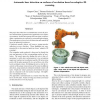Free Online Productivity Tools
i2Speak
i2Symbol
i2OCR
iTex2Img
iWeb2Print
iWeb2Shot
i2Type
iPdf2Split
iPdf2Merge
i2Bopomofo
i2Arabic
i2Style
i2Image
i2PDF
iLatex2Rtf
Sci2ools
3DIM
2005
IEEE
2005
IEEE
Automatic Burr Detection on Surfaces of Revolution Based on Adaptive 3D Scanning
This paper describes how to automatically extract the presence and location of geometrical irregularities on a surface of revolution. To this end a partial 3D scan of the workpiece under consideration is acquired by structured light ranging. The application we focus on is the detection and removal of burrs on industrial workpieces. Cylindrical metallic objects will cause a strong specular reflection in every direction. These highlights are compensated for in the projected patterns, hence ’adaptive 3D scanning’. The triangular mesh produced is then used to identify the axis and generatrix of the corresponding surface of revolution. The search space for finding this axis is four dimensional: a valid choice of parameters is two orientation angles (as in spherical coordinates) and the 2D intersection point with the plane spanned by two out of three axis of the local coordinate system. For finding the axis we test the circularity of the planar intersections of the mesh in different ...
Related Content
| Added | 24 Jun 2010 |
| Updated | 24 Jun 2010 |
| Type | Conference |
| Year | 2005 |
| Where | 3DIM |
| Authors | Kasper Claes, Thomas P. Koninckx, Herman Bruyninckx |
Comments (0)

